Cleaning the chimney in a bathhouse from soot is an integral part of the effective and proper operation of the chimney. All chimneys must be cleaned without exception. Even if the bathhouse has a ceramic chimney, which is one of the most reliable and expensive, it also needs to be cleaned at least 2 times a year.
Soot that settles on the walls of even the smoothest chimney can ignite and lead to undesirable consequences, including complete combustion of the bathhouse. Previously, such a profession as a chimney sweep was quite in demand. Today there are fewer and fewer real specialists. If the design of the chimney in a bathhouse has many bends, you cannot do it without a professional. But if the design of the chimney is simple, then feel free to start cleaning it, but first read useful tips, tested in practice.
How and why does a chimney become dirty?
It is quite important to consider this issue, since, knowing the reasons, you will understand the whole process, know where to start, and then cleaning the chimney will be effective. So, when fuel burns, smoke is formed, and from it the so-called dirt and soot are formed. This happens if you heat a bathhouse with wood.
Next comes the causal process. Due to pollution, it is more difficult for smoke to pass through, draft decreases, and the fuel itself does not have the opportunity to burn in full. Due to contamination, the chimney structure deteriorates, and as a result, due to high temperatures, a fire occurs and, as a result, the entire bathhouse can burn down.
Tools for removing soot from chimneys.

To prevent sad consequences, the chimney must be cleaned regularly. In order to clean a chimney, there are many ways, including those that do not require climbing onto the roof itself. But, everything is in order.
You can clean it with a brush. There are a lot of them, different both in quality and in form. When choosing a brush, you need to pay attention to its length and volume; they must match the volume and length of the chimney itself.
There are also special brushes that can be used to clean the bends of chimney pipes. Nylon is considered one of the highest quality and most convenient materials for making brushes; its fibers are universal, that is, suitable for cleaning any chimney.
The arsenal of chimney cleaning methods also includes the old method using potato chips. To do this, peel the potatoes, collect the chips in a large enough container, such as a bucket, and pour them into the chimney. The whole secret is that when burned, the chips will release starch, which perfectly cleans the pipes and deposits. After this, wait two days and additionally clean the chimney using an aluminum rod brush.
Another old and popular method is to clean the chimney using soot combustion. This method is suitable only for those chimneys that can withstand temperatures of 1100 -1200 degrees above zero. To do this, the stove is heated with aspen wood; within a short time, the soot will ignite and fire will come out of the chimney. This way the chimney is cleaned very effectively, but not always safely.
An equally effective, but painstaking method is to clean the chimney using aluminum cans. To do this, you need to throw an aluminum can into every tenth firebox, and the temperature should be such that the can burns completely.
A fairly simple way to clean a chimney is to use a hose. It can be inserted into the chimney both from above and below, turn on the water, and before that, for greater efficiency, put a brush on the end of the hose. Just a few movements and the chimney is clean, although a little wet.
Some bathhouse attendants cannot do without cleaning with chemicals. In fact, this type of cleaning is more of a preventive measure than a full-fledged cleaning. The fact is that chemistry is not able to completely dissolve the soot, and in some places it will still remain, so the chimney will have to be cleaned again.
Cleaning the chimney from soot in a bathhouse. Chimney cleaning rules.
Cleaning, one might say, is a dirty business. So before you start, you need to protect your furniture, windows, doors, and, of course, yourself. Don't forget about a respirator, gloves, goggles and thick clothing.
So, most chimneys have special doors for checking and cleaning the chimney. We insert a brush through them and very carefully wield it in all directions, rinse off the dirt with ordinary warm water.
Please note that if you have not used the sauna for a long time, birds may have made a nest in the chimney or, worse, wasps have settled there. In any case, before lighting the sauna, check the condition of the chimney, and remember - there is no unnecessary cleaning for the chimney.
How to make your own chimney cleaners?

Our great-grandfathers did not go to hardware stores for any reason, but did everything they needed from improvised means, and not only for the sake of saving money. The thing that's done with my own hands more reliable, better quality and a piece of soul invested in it.
For example, you can make a chimney brush yourself without any problems. To do this you will need a synthetic broom, a steel cable, clamps, two ears, a threaded pin and washers. A little patience, a clear example, and the chimney cleaning brush is ready.
Knowing how to clean a chimney has nothing to do with romance. Of course, it is very pleasant to listen to the fire crackling in the fireplace or stove! Then the heat makes its way through the built-in passages, heating the entire wall area, releasing only combustion waste to the top of the chimney. Including greasy, sticky soot. And if you don’t get rid of it in time with your own hands or the work of invited specialists, you can forget about comfort.
Chimney pipe covered with soot on the inside
Where does the problem come from and what does it threaten?
During the combustion of fuel, especially solid fuel, with gases formed during combustion, ash, tarry substances and various oxides rise into the air. All this looks for roughness in its path and tenaciously “grabs”, gradually reducing the permeability of the pipes and passages in the brickwork of the furnace. And this threatens with unpleasant consequences.
- First, simply by increasing the amount of fuel, which burns much worse when there is a lack of oxygen.
- With the amount of fuel in the firebox, the temperature rises, which at a certain level can ignite soot. The result will be a fire, the most terrible feature of which is the likelihood of fire wooden floor. For some time it will quietly smolder in the attic, and you will feel only smoke, it is unclear where it came from.
- Carbon monoxide is called the silent killer. The same temperature sometimes cracks the furnace masonry, and it is easier for carbon monoxide to escape into your bedrooms than into a clogged chimney. You may not wake up.
Does it look like a horror movie? Yes. And although such cases are extremely rare, it is doubtful that this will make it any easier for the victims.
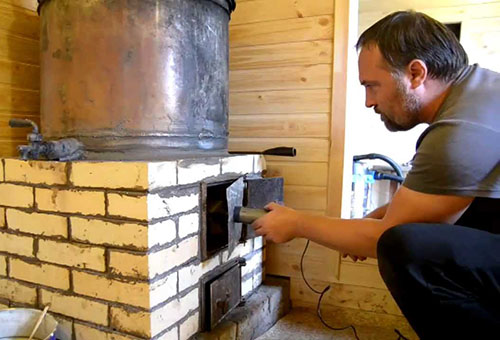
Chimney signals for help
Before you clean the chimney with your own hands, make sure it is necessary. There are several features that will tell the owners about the need to clean it from soot:
- more fuel began to be consumed;
- when the stove is lit, some of the smoke returns;
- the flame turns from bright orange to dark red;
- Thick black smoke comes out of the chimney, even though you are using regular fuel.
Even if the soot layer is not too large, it is better to insure yourself against surprises. In addition, sometimes foreign objects fall into the chimney, even a bird’s nest built over the summer. This means that you must clean it once a year, preferably before the start of the heating season.
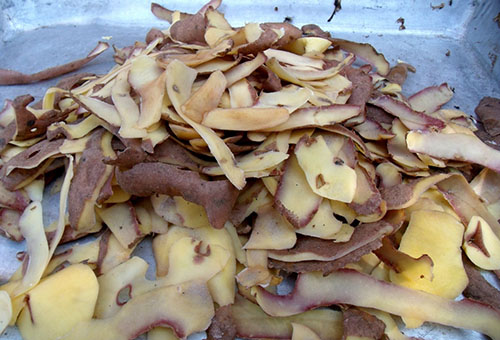
Folk remedies – fairy tales or reality?
Folk remedies can help, and in the most reasonable way - prevention. They have been time-tested and really help, although you can expect the same effectiveness from them as from mechanical or modern ones. chemicals, not worth it. When are they needed? At the height of the season, so that you don’t have to litter an unheated house in the cold with poorly washed soot flakes. And unlike chemicals, you can breathe them without fear.
Not everyone agrees to regularly shovel dirt with their own hands. But how to clean a chimney without this? There are several ways.
- Salt . It is poured onto burning logs. Heating to a high temperature due to chemical reactions, it peels off soot from the walls, but large number will not be able to cope.
- Potato peel. An excellent and always available chimney cleaner. Usually half a bucket is enough, but if the firebox is large, you will have to take more. They need to be poured dry into the heat so that they all burn together at once. A large release of starch will clear the passage. If you carry out the procedure before mechanical cleaning of soot, the starch will soften the layer, and it will be much easier to wipe off the walls.
- . Of course, this tree does not grow everywhere, but if it is available, it is an excellent remedy, which also has great heat transfer. Just throw no more than 2 liters at a time: high combustion temperatures can lead to cracks in the firebox and deformation of its parts. And the soot disappears due to burnout.
- Aspen firewood. The idea is the same - high combustion temperature. So you need to throw a limited amount of this firewood. If the chimney is not strong enough, soot, igniting, can easily tear it apart. It is wiser to repeat the procedure after a few days.
- Birch firewood. Less effective, and to achieve results you need to get rid of the bark.
- Aluminum cans. The information has not been verified for centuries, but is popular among Internet users.

- Potato peelings can be regularly burned in the oven undried instead of thrown away - this will be an excellent preventative against soot deposits inside the outlet channel.
- The situation is similar with nut shells. By buying unshelled nuts, you will not only always have tasty quality product power supply, but you will also have to worry less about problems with the chimney. The heat transfer of the shell is very high; a few handfuls will completely replace half a bucket of coal.
- If the furnace has many bends in the smoke path with bottlenecks, you can’t hope for high efficiency in removing soot the first time. You will have to use folk remedies several times, and rub the pipe with your own hands in the fall with a brush, collecting dirt that falls down through special holes.
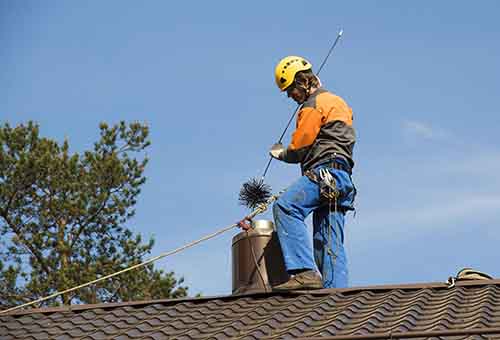
The bathhouse requires special care, since cleanliness in it is the key to both health and pleasure. There are several additional options for cleaning a chimney in a bathhouse with your own hands. Their features depend on whether it is straight or curved.
For direct use in winter, it is important to make a snowball of the inner diameter of the chimney to the size and throw it inside. When the stove is lit, it will flow down the pipe and perfectly clean its walls.
It's another matter if there is still a bend. Then the snow will not help, you will have to take a hose and pour water directly into the pipe. This is one of the most clean options. Just before you clean the pipe in the bathhouse in this way, do not forget to place a pan for water below the firebox. You don’t want to collect dirty liquid all over the flooring?
In both options, you should be aware of the possibility of rust on metal parts. To prevent this from happening, the stove must be heated until the water evaporates.

How to reduce clogging?
The most best treatment– prevention. In order not to take up the brush once again when soft ones no longer help folk options, it's worth knowing which fuels to avoid:
- bags with film, colored paper good quality, painted cardboard boxes give a lot of sediment;
- wet firewood gives off heat worse and produces more waste and soot;
- Cheap types of coal emit huge amounts of oxides and soot when burned.
There is no need to burn them in a stove, and you will have significantly fewer problems with how to clean the pipe.
In any case, it is necessary to remember that the proposed options do not cancel mechanical intervention, but only provide a delay until the moment when you have to clean the chimney in a less pleasant way - using a brush or a simple broom made of broken branches. This is especially true for solid fuel stoves, which are often used at home.
Details Here
Good and regular cleaning of the chimney is necessary even when your stove comes from expensive and modern modular systems. But even with very careful and careful operation, soot still settles on the walls of the pipes, and if you also heat it with not the best wood, then its volume may surprise you. Soot collects even on the smoothest surface, and it needs to be cleaned off - unless, of course, you want your sauna to burn down. But the time is already behind us when only a professional chimney sweep could clean the chimney. Today, in fact, there is no such profession - instead, in some schools they train only “cleaners”, although they cannot boast of special skills. True, occasionally you can find advertisements for the private services of a real chimney sweep. And this makes sense - a professional will not only clean your chimney efficiently, but will also check it itself technical condition chimney. Therefore, if your chimney has bends, it was not made by you and you do not really understand all these subtleties - hire a specialist, it will be safer for your health and life. But if construction is a fairly close topic and the chimney is the work of non-visiting migrant workers, and its design is quite simple - feel free to pick up a brush!
Why does the chimney get clogged in the first place?
Let's take a closer look at this process - and much will immediately become clearer. Thus, when wood burns, smoke is produced and gas is released. White smoke comes from water vapor from wood, and black smoke comes from coal, soot and creosote from the same wood. It is from black smoke that a coating forms on inner surface pipes, and the rougher it is, the more soot will settle on it.
The result: it is more difficult for smoke to pass through, thrust decreases, and fuel does not burn completely. In the best case, the chimney will deteriorate over time, in the worst case, the bathhouse itself will burn down.

How can you get rid of accumulated soot?
Sometimes, rather than hiring a non-professional, it’s much easier and safer to remove soot from your own bathhouse yourself - using brushes, modern chemicals for cleaning chimneys and even “old-fashioned” methods, and without necessarily climbing onto the roof!
Let's look at the most popular options for cleaning soot from a chimney and how to do it.
Using a special brush - a simple and proven method
Of all modern mechanical and chemical means, a brush is the simplest and safest. It is only important to choose one that is suitable for your chimney - both in diameter and in length, so that you do not worry about how to clean your chimney of soot along its entire height.
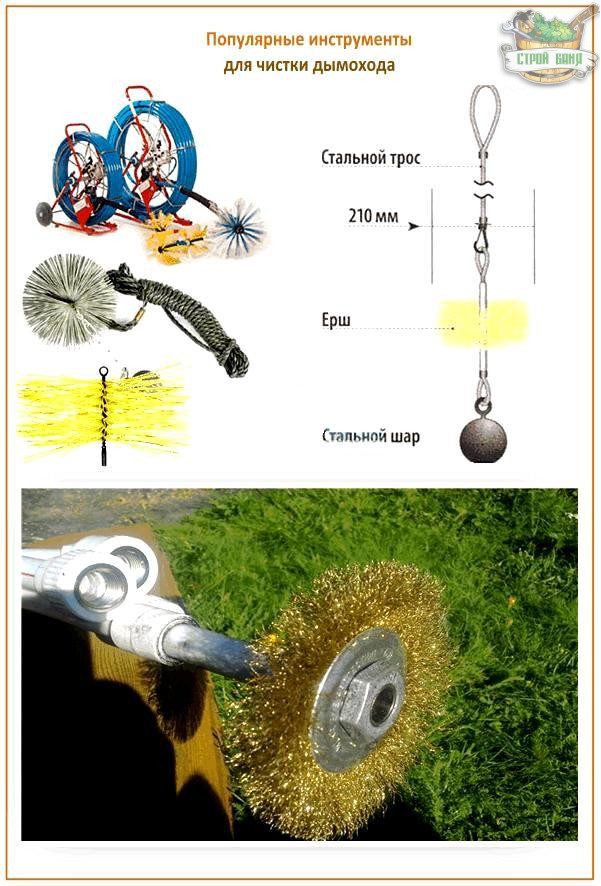
Particularly good is a nylon brush with stiff bristles, which is easy to clean a chimney of any material. Nylon pile is flexible and adapts well to any pipe shape, while simultaneously coping with the most stubborn plaque. But at the same time it does not scratch or damage its inner surface.
The most difficult thing is to choose a good brush for chimney bends. This is where the soot settles, and it is not so easy to get it out. Nylon bristles are most suitable for this - they will easily penetrate into the most inaccessible places, while hard brushes will simply scratch the folded areas. And more scratches - less smoothness - more soot clings.
It is also important what kind of handle the brush has - it must have sufficient flexibility so that it can fit into the most invisible nooks and crannies and at the same time be easy to control your movements.
Potato peeling - the old-fashioned method
Here's how to clean a chimney in this way: throw a bucket or half a bucket of fresh potato peelings into a well-heated stove - that's how much will fit in it. During their burning, starch will be released, and it decomposes the soot. Within two to three days it will almost completely fall off the walls of the chimney and partially fall out. After this, tie a brush made of twigs to the brick and clean the top of the chimney in the classic way - it will be easy!
Aspen wood - with fire from the chimney
Cleaning a chimney with aspen wood is as old as the world. But this method cannot be called safe - let's figure it out.
We put aspen wood in the stove and light it well. They burn well and produce a very high temperature. At this time, all doors and valves of the stove should be open, and do not forget to add more firewood. The result is that the soot itself lights up and the stove begins to make a loud noise. If you go outside at this moment, you will see fire pouring from the chimney on the roof of your bathhouse! And the surrounding area will quickly become covered with large white flakes. But the chimney will be cleaned, and cleaned well. If only it can withstand this test - after all, not every chimney is designed for 1100 ° C, and it is at this mark that soot will burn in it.
Aluminum cans - unusual, but effective
The cans need to be burned once in ten fires - this is enough, and very little soot will be collected. The only condition: the fire must be made hot, with a large amount of hard coal - so that the cans actually burn, and do not lie on the wood and change color. Normally, one can should burn out in five minutes.
Hose - whatever is at hand
Some bathhouse attendants don’t bother themselves much with newfangled methods and clean the chimney with a regular watering hose. The whole procedure looks like this:
- Remove the glass from the bottom of the chimney.
- We insert a hose from below (preferably from above), preferably a hard one.
- A few cleaning movements - all the soot is already at the bottom.
You can additionally attach a cut-up bottle or brush to the end of the same hose - and you will see how easy it is to clean the chimney effectively and cost-effectively!
Chemical cleaning is unpopular and unpleasant
Chemical cleaning of chimneys is more of a preventative measure than a real cleaning. The bottom line is that after this the soot will fall off in places, but you will still have to use an additional brush. Plus, the smell in the bathhouse can last for several days. Therefore, if potato peelings are not available to you, you can buy some “Komichek” or “Log-chimney sweeper”.
How to properly clean a chimney with a brush?
First of all, before cleaning, be sure to cover the furniture in the bathhouse with plastic wrap and cover the windows with thick fabric. Protect yourself from soot: wear gloves, safety glasses and preferably a respirator. Next is this: in most models of stoves and chimneys, manufacturers install special inspection doors to make cleaning easier and more convenient. Pay attention - do you have these?
So, here's how you can clean your chimney well:
- Step 1. We wait until the stove has completely cooled down and remove any remaining firewood or any other flammable materials from it.
- Step 2. Remove the damper at the entrance to the chimney.
- Step 3. Holding the brush firmly by the handle, insert it into the chimney hole.
- Step 4. Move the brush in a variety of directions, trying not to miss any hard-to-reach places.
- Step 5. Move the brush further up, and now clean the highest places of the pipes.
- Step 6. Remove the accumulated soot.
- Step 7. Close the chimney and rinse the brush with regular warm water.
It is necessary to clean not only soot from the chimney, but also cobwebs, accidentally flying debris and sometimes even bird nests. Even if you cleaned the pipe well, and then didn’t use the sauna at all for a month or two of summer, still pick up the brush.
The fact is that during this time the birds could actually build a nest in the chimney, and the small inhabitants of the corners could weave new webs. And if you carelessly light the stove, it will all burn, and it burns with a special soot and unpleasant odor, and even caustic soot, which will instantly stick to the walls and will “delight” you with a suffocating aroma all winter. Do you need it?...
How to make a good brush with your own hands?
Here's how to make a great budget chimney brush:
- Step 1. We purchase the following from the market: a synthetic round broom, a steel cable along the length of the entire chimney, clamps, 2 ears and a pin with 8 mm thread and washers of different diameters.
- Step 2. Unbend the pile in different directions - it is hard and elastic, so make an effort. The result will be something like a bouquet. If it doesn’t work, put it in boiling water.
- Step 3. Take a hairpin and screw the ear - from one end, after which we put on the washer and insert it into the hole at the bottom of the brush, then the washer again. The diameter of them just fits the holes of the broom.
- Step 4. Press down on the base from above and carefully screw on the second fastener. The more you twist, the more the bristles of the brush will diverge to the sides.
- Step 5. Turn the brush over, see the eye of the fastening and tighten it to the desired size.
- Step 6. We fasten the cable to the brush using a bracket, measure the chimney opening and cut the fibers exactly to the size of the chimney pipe. If it turns out to be less, it won’t be cleaned. And for accuracy, first try on and cut out a template from cardboard.
- Step 7. We attach the load - this can be a regular weight from 2 kg.
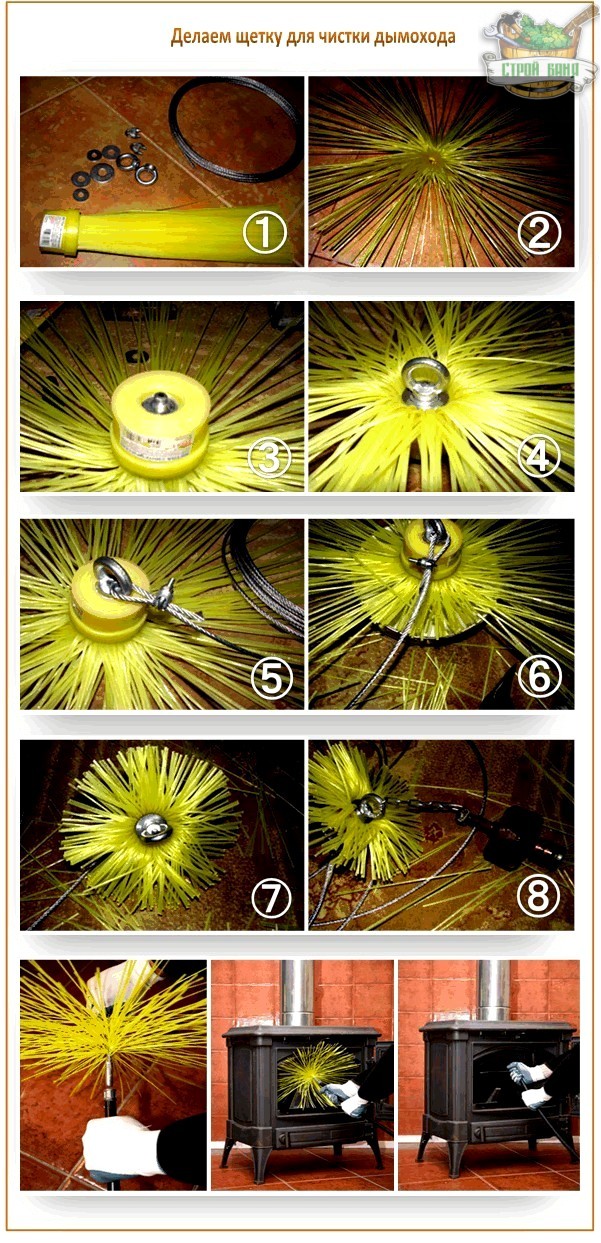
That's it! You can put up a ladder and go clear the chimney of soot. Good luck!
Chimney in country house It is necessary to clean it at least once a year, but if the stove is constantly used, this is not enough (see). In general, it is recommended to clean the pipe every 30 days. You can hire a specialist, but basically everyone tries to clean the chimney themselves. There are many methods, but the most effective is the use of chemicals. There are also old-fashioned methods that also work. But if the pipe is so clogged that there is no draft at all, then you will have to remove the soot manually with a brush.
Mechanical method of soot removal
The most ancient method of cleaning a chimney in a bathhouse or house is to use a special brush. The technique is as simple as the world: take a hard brush and mechanically scrub off the soot from the walls of the chimney. The procedure can be performed both from the roof and from the premises.
To work from the roof, use a brush of the appropriate diameter (slightly smaller than the pipe itself) on a rope. A load of about 3 kg should be suspended below. This cleaning is somewhat reminiscent of winter fishing. All the dirt falls down, where it will then need to be removed. The disadvantage of this method is that it is impossible to remove soot in horizontal areas and in hard-to-reach places (see).
Due to its properties it is a universal insulation material.
We cannot definitely say which one. You need to look at the situation.
To clean a chimney from a room, you need to place a round brush on a flexible stick and push it up the pipe. In this way, you can clean not only the chimney, but also the firebox with the heat exchanger. A significant disadvantage of the mechanical method is that it is very “dirty” and takes a lot of time. In general, there are more acceptable ways to clean soot from chimneys and stoves; read about them further.
Chemicals for cleaning chimneys from soot
The simplest and modern way Do-it-yourself chimney cleaning involves chemicals. The bottom line is that the chemistry burns in the firebox and its gases dry out the adhering soot. After this, all the dirt flakes off, some of it flies out, and some falls down, where it can easily be removed along with the ash. There are two types of chemicals - “log” (briquette) and powder.
A log is a mixture pressed into a briquette. chemical elements, which is packed in paper. This is a one-time measure to combat clogging, which must be used once every 30 days. The product for cleaning chimneys from soot “Log” contains a large amount of reagent, like a battering ram. It includes:
- unregenerated cellulose;
- lapis lazuli;
- ammonium sodium;
- iron sulfate decahydrate;
- calcium chloride;
- functional additives.
The product must be certified and a test report must be indicated on the packaging.
There are also instructions for use on the box. First, you need to heat the oven, then put a bag on the coals (no need to tear the paper). The main requirement is not to place the chemical briquette on an open flame. “Log” smolders for about two hours.
Do-it-yourself chimney cleaning powder should be used as a preventive measure. The manufacturer recommends adding powder continuously for the first six kindlings, and then once per 10 kindlings. The advantage of the chemical cleaning method is that soot is removed from all hard-to-reach places, including the firebox and heat exchanger. With constant preventive maintenance, the entire smoke removal system always remains clean.
Traditional methods for cleaning soot from chimneys
We never liked cleaning the chimney mechanically - there was a lot of dirt. In ancient times there were no chemicals, but our people are very savvy and a solution was found. It was experimentally determined that it is possible to clean a chimney by burning aspen wood or potato peelings in the firebox. Aspen firewood produces great heat, which burns away soot. Using this method you need to be extremely careful. If you have, for example, then it’s better not to risk it.
Potato peelings remove soot due to the combustion of starch, or rather the smoke that is released. To prepare the peelings, you need to spread them in a warm place so that all the moisture is gone. If you throw them into a bucket wet, they will simply become moldy and rot.
Blowing the chimney with air yourself
There is another option for cleaning the chimney from soot in a stove. folk remedies- this is through strong air pressure. The bottom line is that a turbulent flow is created in the chimney, which blows all the dirt out. The main thing is a powerful fan. As an air blower, you can use a chainsaw or a special device for cleaning the area (they blow off leaves in the fall). The fan must draw the flow out of the pipe - otherwise all the soot will go into the house and then there will be no time for experiments. In the video below you can see how to clean a chimney with air in a few minutes.
Those who like to take a steam bath in their own bathhouse often have a question about how to clean the chimney in a bathhouse in the most effective way at minimal cost.
If this is not done in a timely manner, you will soon notice a significant decrease in draft and incomplete combustion of wood in the stove, which can result not only in the failure of the chimney itself, but also in the outbreak of a fire.
Regular cleaning of the chimney from soot is necessary even when modern modular systems are installed in the bathhouse.
The accumulation of soot on the walls of the chimney is a serious problem that today can be dealt with without outside help.
This situation is also relevant for fireplaces equipped with their own chimney and installed in the kitchen of a house or apartment.
In most cases, cleaning is carried out using special devices and products, which today are presented in a large assortment in specialized stores.
Some owners resort to traditional methods, allowing you to get rid of soot in the chimney. How to clean a chimney is described in detail in the video below.
Chemical cleaning methods
Clogging of the chimney, including in the kitchen, occurs due to the fact that the smoke contains small particles. particulate matter, which settle on the walls of the channel and are held together by water vapor generated as a result of the combustion process.
The formation of soot in the chimney from a stove in a bathhouse or kitchen, as well as from a fireplace in an apartment, contributes to a significant deterioration in draft and, as a result, the inability to operate stove equipment.
The chimney can also become clogged from the accidental entry of leaves and other debris into the chimney or from collapsing brickwork.
Before cleaning a chimney pipe in a bathhouse or kitchen, it is recommended that you familiarize yourself with each method separately and choose the most effective one.

So, a fairly old and time-tested method of cleaning a chimney (including in the kitchen) from soot, which our ancestors used, is burning the stove with dry aspen wood.
When this type of wood burns, the flame temperature reaches quite high levels, which promotes burning of plaque and cleaning of the channel.
In addition, you can try burning potato peelings, the smoke of which loosens the soot deposits and makes it easy to clean it off the surface.
Nowadays, in specialized stores you can purchase special chemical compounds that facilitate quick and effective cleaning of chimneys in a bathhouse.
They are released in different forms, ranging from powders and tablets to liquids and briquettes. These products are placed together with firewood in the stove and completely burned.
During their combustion, they emit smoke saturated with chemicals, which promotes the decomposition of resins, as a result of which small particles of soot are carried out with the air flow, and large ones fall down.
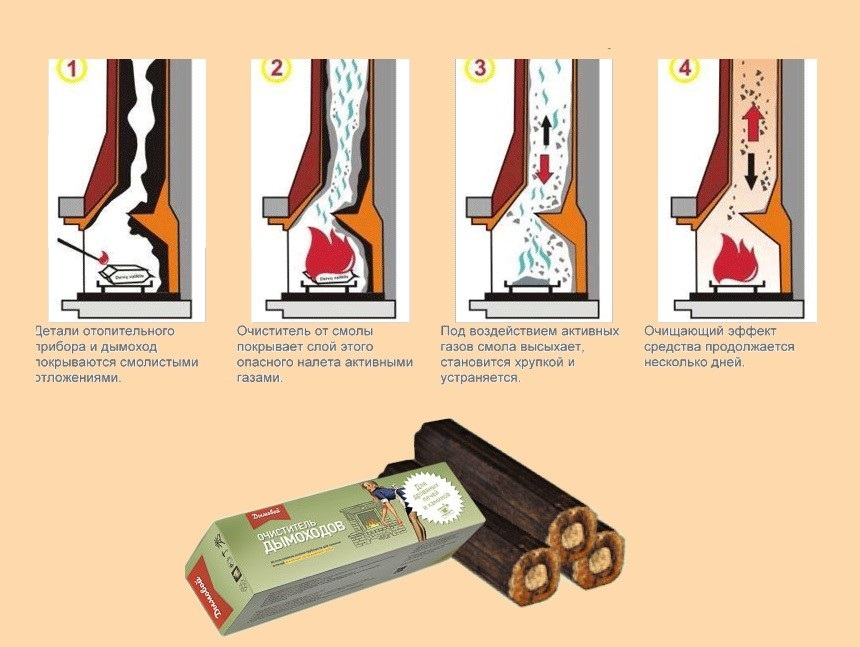
Typically, when burning data chemical compositions the color of the flame becomes blue or green. This means that the product is effective.
This prevention should be carried out at least once a month, before the chimney has time to become completely clogged with soot.
Mechanical cleaning methods
Chemical compounds are not always effective when cleaning a chimney in a bathhouse or kitchen.
All sorts of debris can get into the pipe, which will interfere with the formation of draft and interfere with the combustion of special chemicals.
The pipe can be cleaned using brushes, scrapers and ruffs of various sizes and shapes.
In addition, in some cases, a special core with a cable attached to it may be required, with which you can break through fairly dense blockages.
All these devices for cleaning smoke ducts can be purchased at the store or made independently.
It is best to start cleaning the chimney from the top of the pipe, gradually working your way down. Carry out cleaning through equipped cleaning doors.
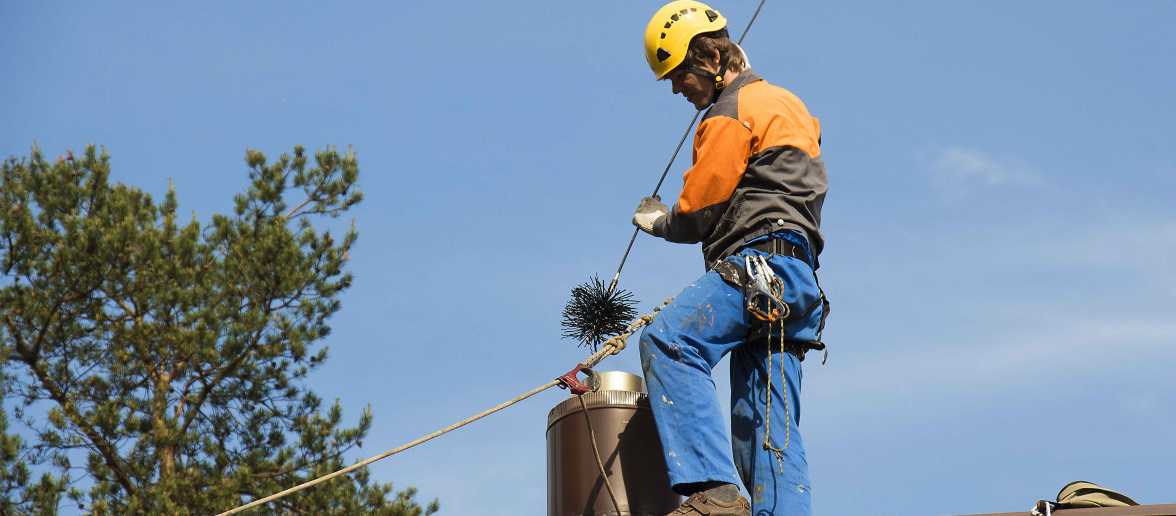
Lastly, clean the firebox itself and the ash pan adjacent to it.
Before starting all work on cleaning the chimney on the roof of the house, the ladder is well secured. You should also open all the dampers and, conversely, tightly close the openings of the firebox and ash pan.
In addition, the head is first dismantled from chimney. All work must be performed wearing a respirator.
It is a cable, at one end of which there is a handle for rotation, and at the other - a special nozzle, the diameter of which should be slightly larger than the diameter of the pipe itself.
The cable is moved along the smoke channel by rotating the handle as carefully as possible.
If the brush's progress stalls, it means it has encountered a dense blockage that will have to be broken through using a core.
It should be lowered into the pipe with sharp movements, without touching its walls, otherwise it can break brickwork. After removing the blockage, continue cleaning with a flexible brush.
After the pipe is completely cleaned, it is necessary to remove soot through special cleaning doors.
In most cases, several such doors are installed along the entire length of the smoke duct.
First, the channel is cleared of soot that has fallen from above, after which, using a scraper and a brush, its walls are cleaned, gradually moving downward, where the firebox is located.
Some stoves have a straight chimney structure with no cleanout doors. In this case, the soot removed from the channel walls falls into the furnace.
At the final stage, you should thoroughly clean the ash pan and firebox. To do this, you can use a vacuum cleaner, which is first recommended to be equipped with a disposable paper garbage bag.
At the end of the work, you should light the stove and check the presence and quality of draft. If everything went well, then the previously removed head is mounted on the top of the pipe.
To ensure that the chimney from the stove or fireplace gets clogged as little as possible, it is recommended to use only firewood hardwood trees.
Use conifers It is dangerous because when they burn, they release an increased amount of resin, which tends to settle in a dense layer on the walls of the smoke channel in the form of a viscous mass.
It is also undesirable to use even a small amount of diesel fuel to light the stove, which contributes to the formation of a dense coating on the chimney.
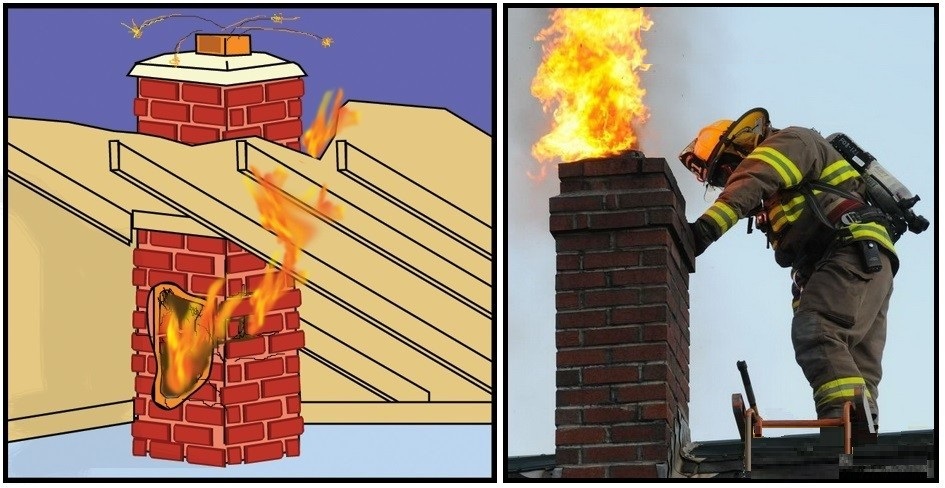
All wood that is intended to be burned in a stove or fireplace must be thoroughly dried.
When burning, wet wood releases wet steam, which not only contributes to the accumulation of soot and soot on the walls of the chimney, but also destroys the chimney itself.
It is worth completely abandoning the burning of all kinds of rags, plastic bags, rubber products, as well as plastic bottles and other similar garbage.
The fact is that the combustion products of various synthetic materials form a very dense coating on the walls of the smoke channel, which is extremely difficult to clean off.
In addition, when burned, these materials emit smoke, which is hazardous to the health of both people and animals.
As a preventive measure, at the end of each heating of the stove, it is recommended to burn several aspen logs in it or generously sprinkle the remains of smoldering firewood with salt.
This will help prevent excessive soot settling on the smoke duct. In any case, plaque forms in the chimney over time, regardless of the firewood used and the observance of preventive measures.
You should make it a rule to regularly inspect it and, if necessary, clean it.
Cleaning chimneys of combustion products and soot should be approached with full responsibility.
The oven will not be able to function properly if it is clogged, and this can lead to serious consequences, including a fire.
In the event that you cannot cope with cleaning the smoke duct on your own, it is recommended to seek help from the appropriate specialists.
How to properly clean a smoke duct in various ways, described in detail in the video posted above.